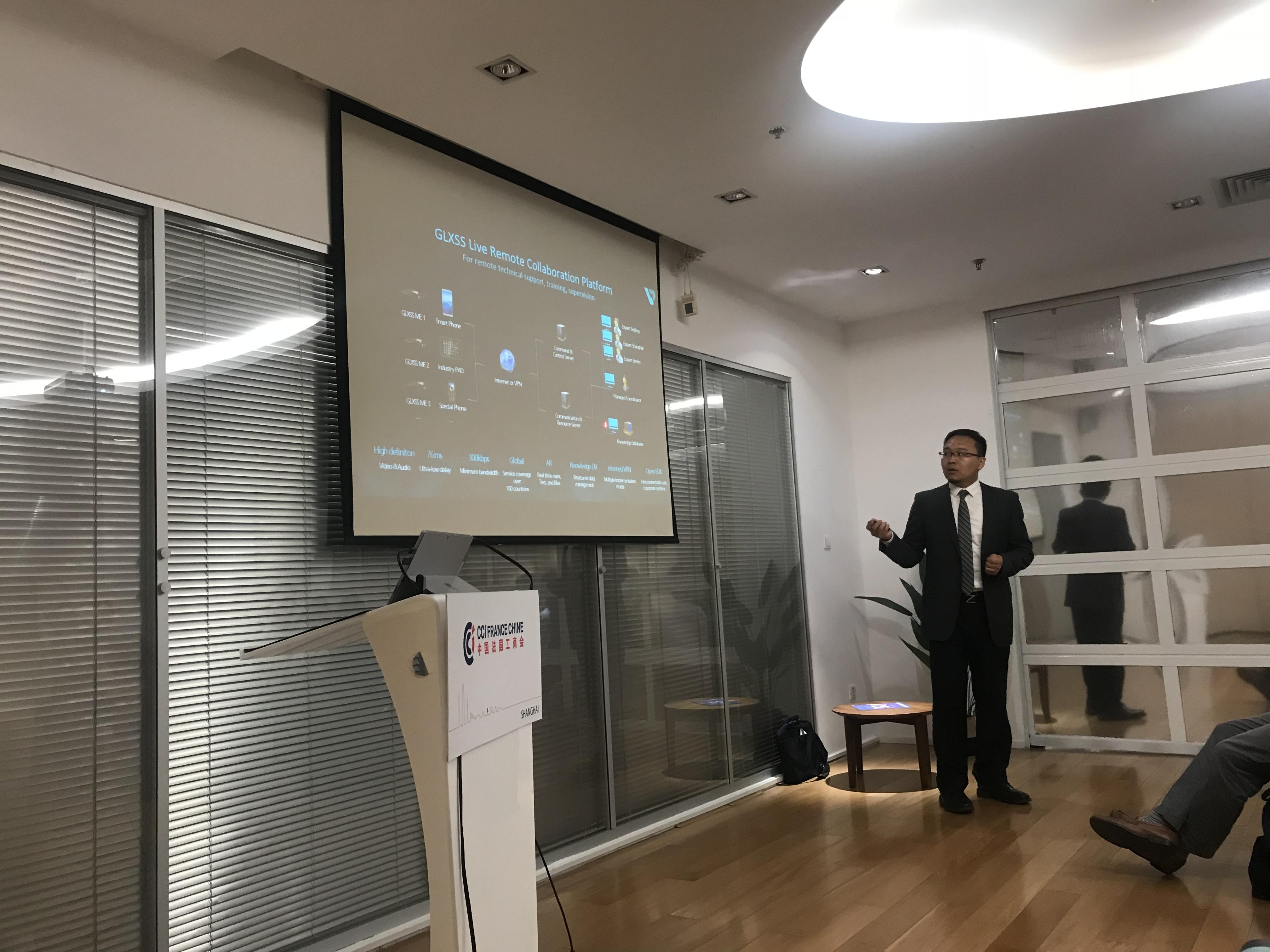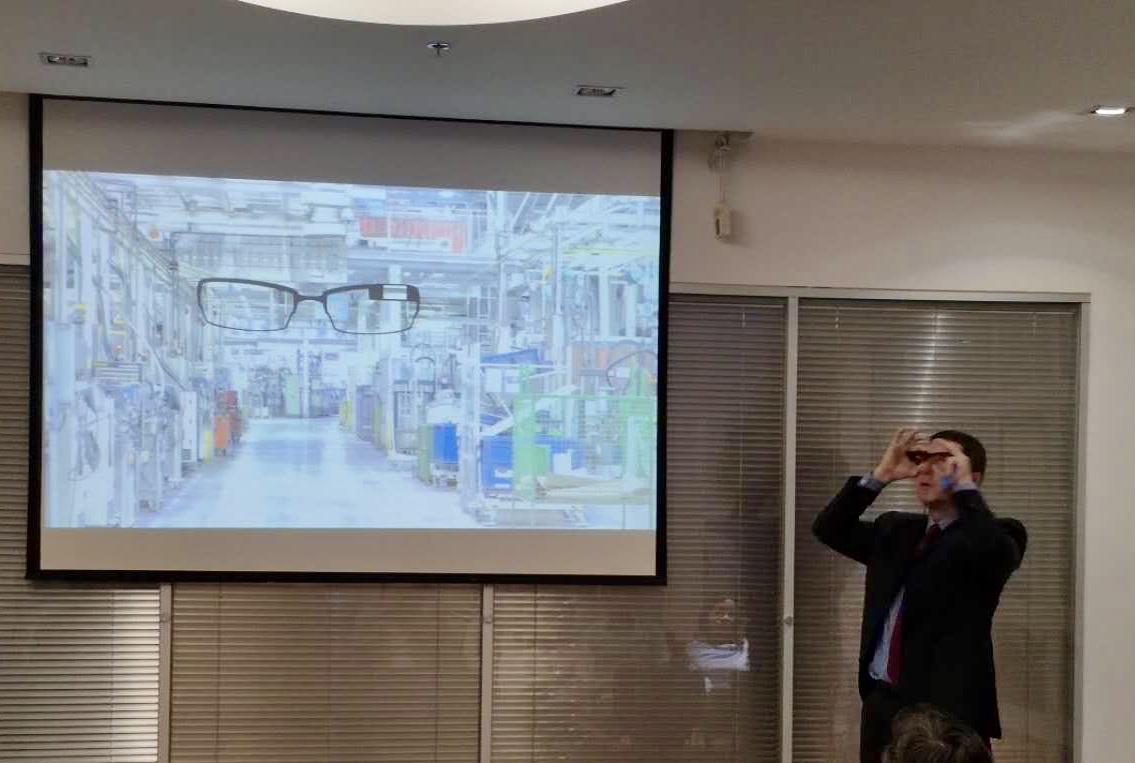Feedback from the “Industry of the Future” Working Group on “Smart Glasses solutions for industrial asset management” featuring bluebee® for smart glasses
On June 12, in Shanghai, the “Industry of the Future” working group of Chamber of Commerce and Industry France-China (CCIFC) held a session on “Smart Glasses solutions for industrial asset management”.
The working group was initially started in 2006 by Siveco’s Managing Director Bruno Lhopiteau under the name “Construction & Maintenance” and was later renamed “Industry of the Future” to more accurately reflects the topics covered. Often ahead of industry trends, since 2006, almost all sessions have actually touched on industrial IT topics!
Around 30 executives from member companies joined the seminar. The main speaker was Li Wenjiang, International Business Head at Beijing LLVISION Technology. Beijing LLVISION Technology is the maker of the GLXSS Augmented Reality (AR) glasses that have recently gained worldwide media recognition for their pioneering use by the Chinese police for security checks based on face recognition.
The presentation focused on industrial applications, most specifically for assets management, operation and maintenance. The speaker touched on the development of LLVISION, current Industry 4.0 trends, artificial intelligence, collaboration and of course the GLXSS technology itself. Mr. Li also covered usability and personal safety issues, too often ignored in the overhyped context of the “digital plant”.

Li Wenjiang, International Business Head at LLVISION, introducing GLXSS AR glasses
Client cases were presented such as Huawei (technical support), Bureau Veritas (remote inspections) and the ongoing cooperation with Siveco: bluebee® for smart glasses. The new smart glass solution is developed jointly with Siveco China as an add-on to bluebee® app, a widely-used award-winning mobile app for O&M staff. Ample Q&A time was provided at the end of the session.
Some of the seminar takeaways include:
The topic (4.0 in general) is considered very exciting by all, but most companies still lack the basic building blocks.
From our perspective, the building blocks are: a central up-to-date maintenance database with historical records. In our experience the only way to keep it up to date is to equip technicians with mobiles (to avoid cumbersome paper + input process which kills most CMMS projects) and connection to machine supervision to collect only relevant/useful data (from IoT/SCADA etc.). With such a foundation in place, it is possible to build up what is usually considered the “low hanging fruit” of 4.0: predictive maintenance.
The challenge is that most companies are still far from this stage, often relying on an ERP + printed paper process, with mostly inaccurate or useless maintenance data.
Most 4.0 projects are then more or less “cosmetic” – recent examples include: facial recognition to identify employees at the gate, tablets connected to machines to replace the traditional HMI, additional IoT sensors connected to an external cloud for energy monitoring (but not connected to anything else) and a lot of experimental projects (AR/VR) which are never put into real day-to-day usage.
Mobility is on the other hand a very practical approach to build a 4.0 solution for maintenance.
With the “smart glasses” option to give mobility a higher-tech feel. One feedback from the meeting is most people still consider smart glasses a gimmick and there is a lot of confusion between smart/AR glasses like GLXSS (that do not obstruct the field of vision i.e. you can work in the plant) and VR goggles (which can only be used in the office in “video game” mode). Some attendees believe that the technology has already been available for many years, presumably based on media report of early solutions, although only the most cutting-edge technology is seeing real life applications, LLVISION being the most striking example of wide adoption by Chinese police forces.
How to overcome corporate IT hurdles with 4.0 technology.
The mobile approach may also be useful to escape typical corporate IT constraints often faced by multinationals: global choice of certain CMMS/ERP software, used in the old way (CMMS + printed paper + data-entry clerk), which inevitably fail in China. The mobility approach (with or without smart glasses) leave the corporate CMMS/ERP in place, while focusing on the reliability improvement process (support for technicians, replacing printed paper and manual data entry). Indeed most companies consider mobility to be outside the corporate CMMS/ERP. Furthermore we see that more and more multinationals realize that China is a good testing field for such technologies.
About bluebee® for smart glasses
The solution is fully integrated in the standard bluebee® app for Operation & Maintenance, running on Android mobile phones. bluebee® for smart glasses is automatically enabled when the phone detects the presence of the GLXSS. The phone can then be left in the pocket, while the technician conducts its inspection round hands-free.
The AR display in GLXSS shows essential information, such as equipment identification, ongoing action details and status (“scan QR code”, “take photo”, “create fault report”, etc.). The app accepts simple voice commands (reporting of inspection results “ok” or “defect”) to avoid using the phone during work. The GLXSS glass camera is used for scanning of QR codes (to identify equipment, inspection point or meters), taking photos and recording videos. The app also integrates with GLXSS Live for remote support by experts.

Bruno Lhopiteau, Siveco’s Managing Director, demonstrating bluebee® for smart glasses
The version 1 of bluebee® for smart glasses was demonstrated during this event (June 2018). A field-tested version 2 will be released in December 2018.
The session concluded with a survey of audience for upcoming topics, followed by a cocktail offered by the CCIFC.
Apart from this regular working group at CCIFC, Siveco conducts similar sharing sessions around Industry 4.0 topics for other business associations or specific customer groups. If you have an interest in such seminars, do not hesitate to contact our marketing team at info@sivecochina.com.




